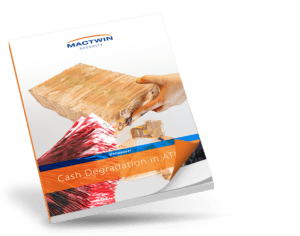How safe are IBNS in ATMs?
IBNS (Intelligent Banknote Neutralisation Systems), also known as cash degradation solutions, are meant to counteract explosive (gas) attacks on ATMs. These systems use ink/dye, glue or a combination of the two to render the cash inside the ATM cassettes worthless. But how about the safety of these systems for e.g. the ATM servicing crew?
For starters, the degradation fluids (ink and glue) are no more dangerous than common household cleaning chemicals everybody has at home. Just like for these detergents, there are guidelines and precautions regarding the use of degradation fluids. Moreover, IBNS manufacturers have ensured that users (like the ATM Servicing crew) won’t be exposed to the fluid in their day-to-day operation. Degradation fluids are safely contained in cartridges and are only dispersed upon activation. As long as there’s no activation, there’s no health risk for the ATM Servicing crew.
To assess exactly how safe an IBNS is, you could ask the following four questions:
1. Which safety precautions are built into the system to prevent misuse and subsequent unwanted activation?
Cash degradation solutions in ATM cassettes are exclusively activated in case of a criminal attack. However, if a user does not follow the correct procedure or misuses the system in some way, the sabotage countermeasures might trigger the IBNS to activate accidentally. For obvious reasons, this must be prevented at all costs. Most products are designed to minimise user error. The safety precautions are usually described in the user manual. If you can’t find them there, it is important to ask the manufacturer about them.
2. Does the IBNS use a high-pressure or low-pressure dispersal method?
When you assess the health risks, be sure to take into account how the degradation fluid is dispersed in the ATM cassette. The majority of the available solutions use high-pressure dispersion to cover the banknotes. There are only some that use low-pressure dispersion. It goes without saying that low-pressure systems pose much less of a health risk (glue or ink is contained inside the ATM cassette) than high-pressure systems that spread the fluid much more violently.
3. Are there manuals and procedural guidelines available?
Manufacturers are responsible for providing clear user manuals and delivering them to the ATM owners (usually banks). After that, it’s up to the ATM Servicing parties to properly educate and instruct their staff. Not only limited to the work at hand, but also regarding the safety precautions and procedures. ATM Servicing parties are also responsible for providing personal protection equipment, if applicable. Banks that are considering cash degradation solutions in their ATMs would do well to critically review the available manuals and procedures.
4. What does the Material Safety Data Sheet (MSDS) state?
Every IBNS should have an MSDS. This contains information about the potential hazards (health, fire, reactivity and environmental) and describes what to do if someone is exposed to the degradation fluid. Review this document critically.


